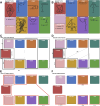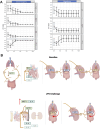Computational inference of chemokine-mediated roles for the vagus nerve in modulating intra- and inter-tissue inflammation
- PMID: 40809119
- PMCID: PMC12341964
- DOI: 10.3389/fsysb.2024.1266279
Computational inference of chemokine-mediated roles for the vagus nerve in modulating intra- and inter-tissue inflammation
Abstract
Introduction: The vagus nerve innervates multiple organs, but its role in regulating cross-tissue spread of inflammation is as yet unclear. We hypothesized that the vagus nerve may regulate cross-tissue inflammation via modulation of the putatively neurally regulated chemokine IP-10/CXCL10. Methods: Rate-of-change analysis, dynamic network analysis, and dynamic hypergraphs were used to model intra- and inter-tissue trends, respectively, in inflammatory mediators from mice that underwent either vagotomy or sham surgery. Results: This analysis suggested that vagotomy primarily disrupts the cross-tissue attenuation of inflammatory networks involving IP-10 as well as the chemokines MIG/CXCL9 and CCL2/MCP-1 along with the cytokines IFN-γ and IL-6. Computational analysis also suggested that the vagus-dependent rate of expression of IP-10 and MIG/CXCL9 in the spleen impacts the trajectory of chemokine expression in other tissues. Perturbation of this complex system with bacterial lipopolysaccharide (LPS) revealed a vagally regulated role for MIG in the heart. Further, LPS-stimulated expression of IP-10 was inferred to be vagus-independent across all tissues examined while reducing connectivity to IL-6 and MCP-1, a hypothesis supported by Boolean network modeling. Discussion: Together, these studies define novel spatiotemporal dimensions of vagus-regulated acute inflammation.
Keywords: chemokines; inflammation; systems biology; vagotomy; vagus nerve.
Copyright © 2024 Shah, Zamora, Barclay, Yin, El-Dehaibi, Addorisio, Tsaava, Tynan, Tracey, Chavan and Vodovotz.
Conflict of interest statement
YV is a co-founder of, and stakeholder in, Immunetrics, Inc. and a member of the advisory board of Anuna AI. Neither of these relationships impacted the work contained in this manuscript. The remaining authors declare that the research was conducted in the absence of any commercial or financial relationships that could be construed as a potential conflict of interest. The author(s) declared that they were an editorial board member of Frontiers, at the time of submission. This had no impact on the peer review process and the final decision.
Figures





References
LinkOut - more resources
Full Text Sources
Research Materials
Miscellaneous

